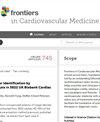依维莫司和波利莫司洗脱冠状动脉支架与依维莫司洗脱生物可吸收血管支架的十年临床疗效对比--来自EVERBIO-2试验的启示
IF 2.8
3区 医学
Q2 CARDIAC & CARDIOVASCULAR SYSTEMS
引用次数: 0
摘要
背景生物可吸收血管支架(BVS)作为一种潜在的解决方案被开发出来,用于减轻经皮冠状动脉介入治疗冠状动脉疾病时药物洗脱金属支架(DES)引起的后期并发症。本研究旨在比较 BVS 与 DES 治疗患者的 10 年临床疗效。方法EverBio-2试验(依维莫司洗脱冠状动脉支架与依维莫司洗脱生物可吸收血管支架的比较)是一项单中心、评估者盲法随机对照试验,共纳入240例患者,按1:1:1的比例分配接受BVS、依维莫司洗脱支架或生物洗脱支架(BES)治疗。结果222名患者(93%)在10年后完成了临床随访。10年时,DES组的器械导向复合事件(DOCE)发生率为28%,BVS组为29%(P = 0.72)。同样,10 年时,DES 组患者导向复合事件 (POCE) 发生率为 55%,BVS 组为 49%(P = 0.43)。值得注意的是,靶血管内心肌梗死(MI)的发生率在 BVS 组为 5%,在 BES 组为 0%(P = 0.04),而任何 MI 的发生率在 BVS 组为 10%,在 BES 组为 2%(P = 0.04)。此外,学术研究联合会(ARC)可能的支架血栓形成率在BVS组为3%,在DES组为0%(P = 0.04)。结论10年来,BVS组和DES组的临床DOCE和POCE率相似,但BVS组的支架血栓形成的个别结果比DES组高(3%)。本文章由计算机程序翻译,如有差异,请以英文原文为准。
Ten-year clinical outcomes of everolimus- and biolimus-eluting coronary stents vs. everolimus-eluting bioresorbable vascular scaffolds—insights from the EVERBIO-2 trial
BackgroundBioresorbable vascular scaffolds (BVSs) have been developed as a potential solution to mitigate late complications associated with drug-eluting metallic stents (DESs) in percutaneous coronary intervention for coronary artery disease. While numerous studies have compared BVSs to DESs, none have assessed clinical outcomes beyond 5 years.ObjectivesThis study aimed to compare the 10-year clinical outcomes of patients treated with BVSs vs. DESs.MethodsThe EverBio-2 trial (Comparison of Everolimus- and Biolimus-Eluting Coronary Stents with Everolimus-Eluting Bioresorbable Vascular Scaffold) is a single-center, assessor-blinded, randomized controlled trial that enrolled 240 patients allocated in a 1:1:1 ratio to receive BVSs, everolimus-eluting stents, or biolimus-eluting stents (BESs). Clinical follow-up was scheduled for 10 years.ResultsClinical follow-up was completed in 222 patients (93%) at the 10-year mark. The rate of device-oriented composite events (DOCE) was 28% in the DES group and 29% in the BVS group (p = 0.72) at 10 years. Similarly, the rate of patient-oriented composite events (POCE) was 55% in the DES group and 49% in the BVS group (p = 0.43) at 10 years. Notably, the rate of myocardial infarction (MI) within the target vessel was 5% in the BVS group and 0% in the BES group (p = 0.04), while the rate of any MI was 10% in the BVS group and 2% in the BES group (p = 0.04). In addition, the rate of Academic Research Consortium (ARC) possible stent thrombosis was 3% in the BVS group and 0% in the DES group (p = 0.04).ConclusionsOver 10 years, the rates of clinical DOCE and POCE were similar between the BVS and DES groups but individual outcomes of stent thrombosis were higher (3%) in the BVS group compared to the DES group.Clinical Trial RegistrationClinicalTrials.gov , identifier (NCT01711931).
求助全文
通过发布文献求助,成功后即可免费获取论文全文。
去求助
来源期刊

Frontiers in Cardiovascular Medicine
Medicine-Cardiology and Cardiovascular Medicine
CiteScore
3.80
自引率
11.10%
发文量
3529
审稿时长
14 weeks
期刊介绍:
Frontiers? Which frontiers? Where exactly are the frontiers of cardiovascular medicine? And who should be defining these frontiers?
At Frontiers in Cardiovascular Medicine we believe it is worth being curious to foresee and explore beyond the current frontiers. In other words, we would like, through the articles published by our community journal Frontiers in Cardiovascular Medicine, to anticipate the future of cardiovascular medicine, and thus better prevent cardiovascular disorders and improve therapeutic options and outcomes of our patients.
 求助内容:
求助内容: 应助结果提醒方式:
应助结果提醒方式:


